Foreword / YouTube Video Review
Note: These speakers were loaned to me by a viewer in brand new in box condition. Multi-tone stimulus was played through these speakers for about 3 days’ time before listening/testing (not that I personally think it is needed but to calm anyone’s concerns about “break in”).
If you are interested in seeing my review of the Klipsch Heresy IV click this link.
The review on this website is a brief overview and summary of the objective performance of this speaker. It is not intended to be a deep dive. Moreso, this is information for those who prefer “just the facts” and prefer to have the data without the filler. The video below has more discussion.
Information and Photos
Some specs from the manufacturer:
- Product highlights:
- matched pair of floor-standing speakers
- designed and hand-built in Hope, Arkansas
- three-way design with passive radiator
- frequency response: 38-20,000 Hz (±3dB)
- power handling: 100 watts (400 watts peak)
- sensitivity: 99 dB
- nominal impedance: 8 ohms
- tweeter: 1" titanium-diaphragm compression driver with horn-loaded design
- midrange: 1-3/4" titanium-diaphragm compression driver with horn-loaded design
- woofer: 12" fiber-composite cone
- 15" passive bass radiator reinforces low-frequency output
- The crossover points are 5.2kHz and 650Hz
- book-matched real American walnut wood veneer finish
- veneer leaves for the left and right speakers are crafted from the same piece of timber
- they’re precisely arranged to provide an aesthetically pleasing “mirror” image at the splice
- includes removable Salt and Pepper cloth grille
- dual gold-plated speaker binding posts allow bi-amping or and bi-wiring
- 16-1/2"W x 36"H x 13"D (each)
- weight: 72 lbs. (each)
- warranty: 10 years
Price is approximately $5000 USD for the pair.
If you are interested in purchasing this speaker, please consider using the following affiliate link which earns me a small commission at no additional cost to you: Just-Audio.com
CTA-2034 (SPINORAMA) and Accompanying Data
All data collected using Klippel’s Near-Field Scanner. The Near-Field-Scanner 3D (NFS) offers a fully automated acoustic measurement of direct sound radiated from the source under test. The radiated sound is determined in any desired distance and angle in the 3D space outside the scanning surface. Directivity, sound power, SPL response and many more key figures are obtained for any kind of loudspeaker and audio system in near field applications (e.g. studio monitors, mobile devices) as well as far field applications (e.g. professional audio systems). Utilizing a minimum of measurement points, a comprehensive data set is generated containing the loudspeaker’s high resolution, free field sound radiation in the near and far field. For a detailed explanation of how the NFS works and the science behind it, please watch the below discussion with designer Christian Bellmann:
The reference plane in this test is at the tweeter*. Testing was performed without the grille.
Measurements are provided in a format in accordance with the Standard Method of Measurement for In-Home Loudspeakers (ANSI/CTA-2034-A R-2020). For more information, please see this link.
CTA-2034 / SPINORAMA:
The On-axis Frequency Response (0°) is the universal starting point and in many situations it is a fair representation of the first sound to arrive at a listener’s ears.
The Listening Window is a spatial average of the nine amplitude responses in the ±10º vertical and ±30º horizontal angular range. This encompasses those listeners who sit within a typical home theater audience, as well as those who disregard the normal rules when listening alone.
The Early Reflections curve is an estimate of all single-bounce, first-reflections, in a typical listening room.
Sound Power represents all of the sounds arriving at the listening position after any number of reflections from any direction. It is the weighted rms average of all 70 measurements, with individual measurements weighted according to the portion of the spherical surface that they represent.
Sound Power Directivity Index (SPDI): In this standard the SPDI is defined as the difference between the listening window curve and the sound power curve.
Early Reflections Directivity Index (EPDI): is defined as the difference between the listening window curve and the early reflections curve. In small rooms, early reflections figure prominently in what is measured and heard in the room so this curve may provide insights into potential sound quality.

Early Reflections Breakout:
Floor bounce: average of 20º, 30º, 40º down
Ceiling bounce: average of 40º, 50º, 60º up
Front wall bounce: average of 0º, ± 10º, ± 20º, ± 30º horizontal
Side wall bounces: average of ± 40º, ± 50º, ± 60º, ± 70º, ± 80º horizontal
Rear wall bounces: average of 180º, ± 90º horizontal

Estimated In-Room Response:
In theory, with complete 360-degree anechoic data on a loudspeaker and sufficient acoustical and geometrical data on the listening room and its layout it would be possible to estimate with good precision what would be measured by an omnidirectional microphone located in the listening area of that room. By making some simplifying assumptions about the listening space, the data set described above permits a usefully accurate preview of how a given loudspeaker might perform in a typical domestic listening room. Obviously, there are no guarantees, because individual rooms can be acoustically aberrant. Sometimes rooms are excessively reflective (“live”) as happens in certain hot, humid climates, with certain styles of interior décor and in under-furnished rooms. Sometimes rooms are excessively “dead” as in other styles of décor and in some custom home theaters where acoustical treatment has been used excessively. This form of post processing is offered only as an estimate of what might happen in a domestic living space with carpet on the floor and a “normal” amount of seating, drapes and cabinetry.
For these limited circumstances it has been found that a usefully accurate Predicted In-Room (PIR) amplitude response, also known as a “room curve” is obtained by a weighted average consisting of 12 % listening window, 44 % early reflections and 44 % sound power. At very high frequencies errors can creep in because of excessive absorption, microphone directivity, and room geometry. These discrepancies are not considered to be of great importance.

Horizontal Frequency Response (0° to ±90°):

Vertical Frequency Response (0° to ±40°):

Horizontal Contour Plot (not normalized):
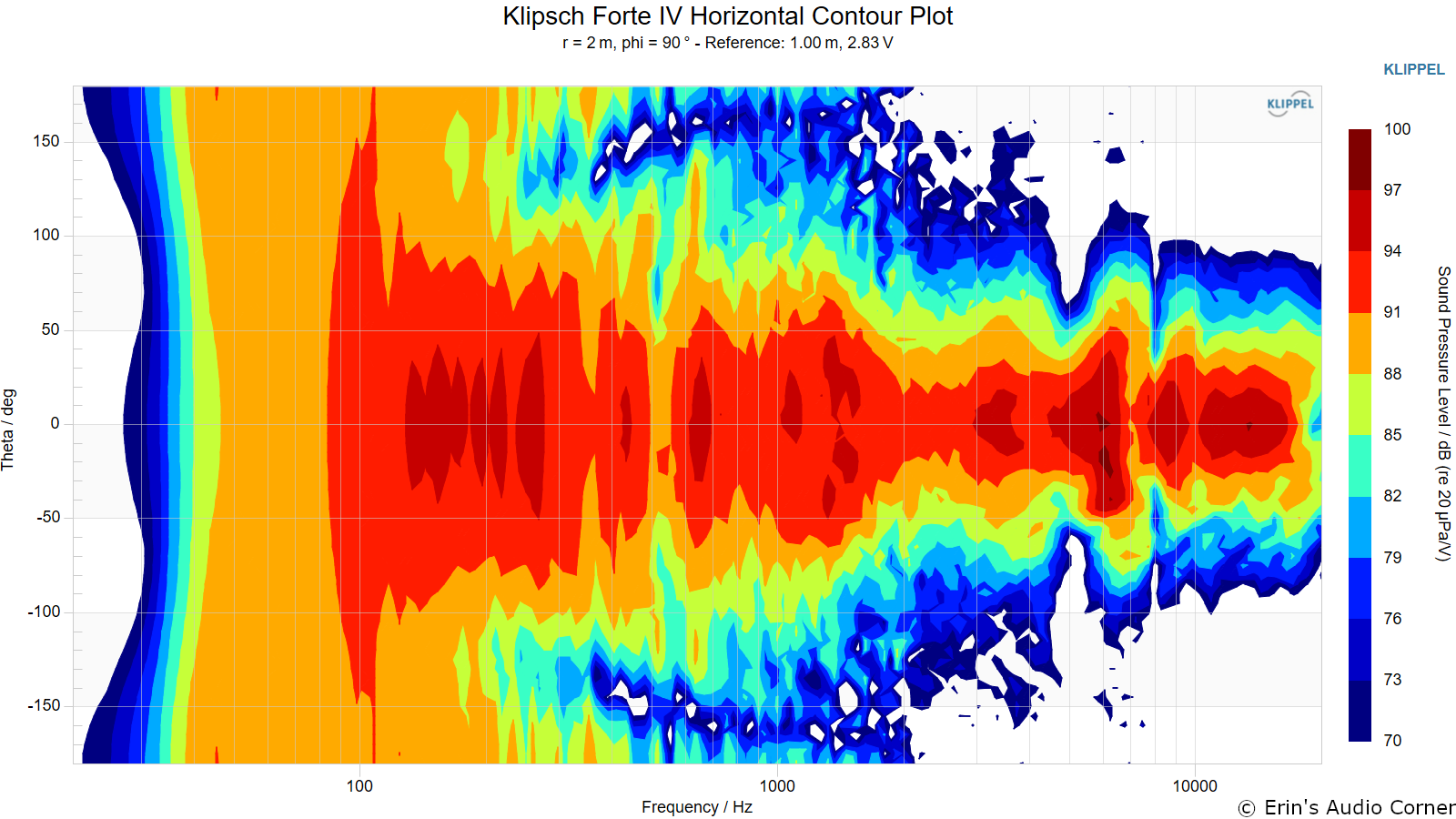
Horizontal Contour Plot (normalized):
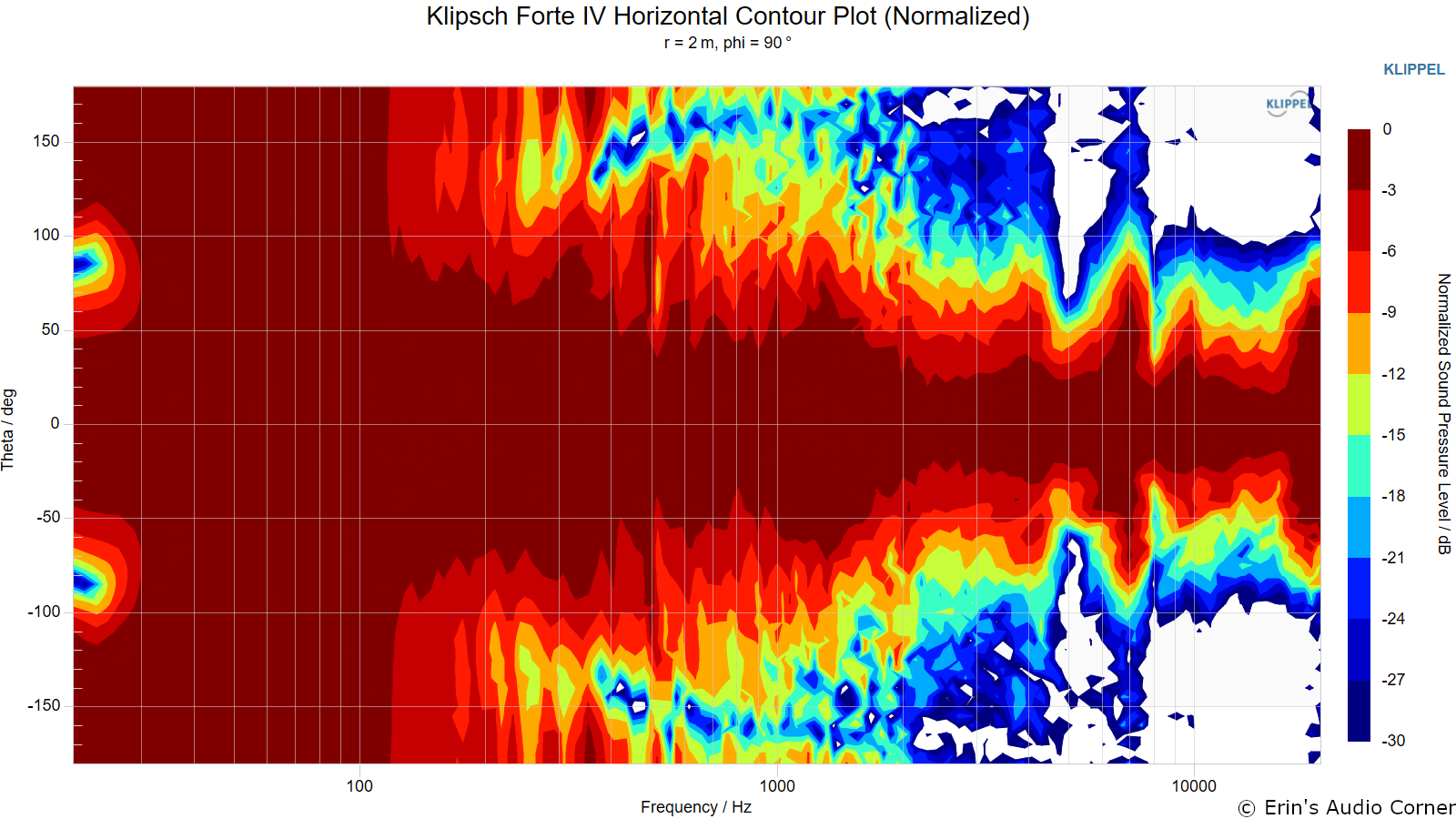
Vertical Contour Plot (not normalized):
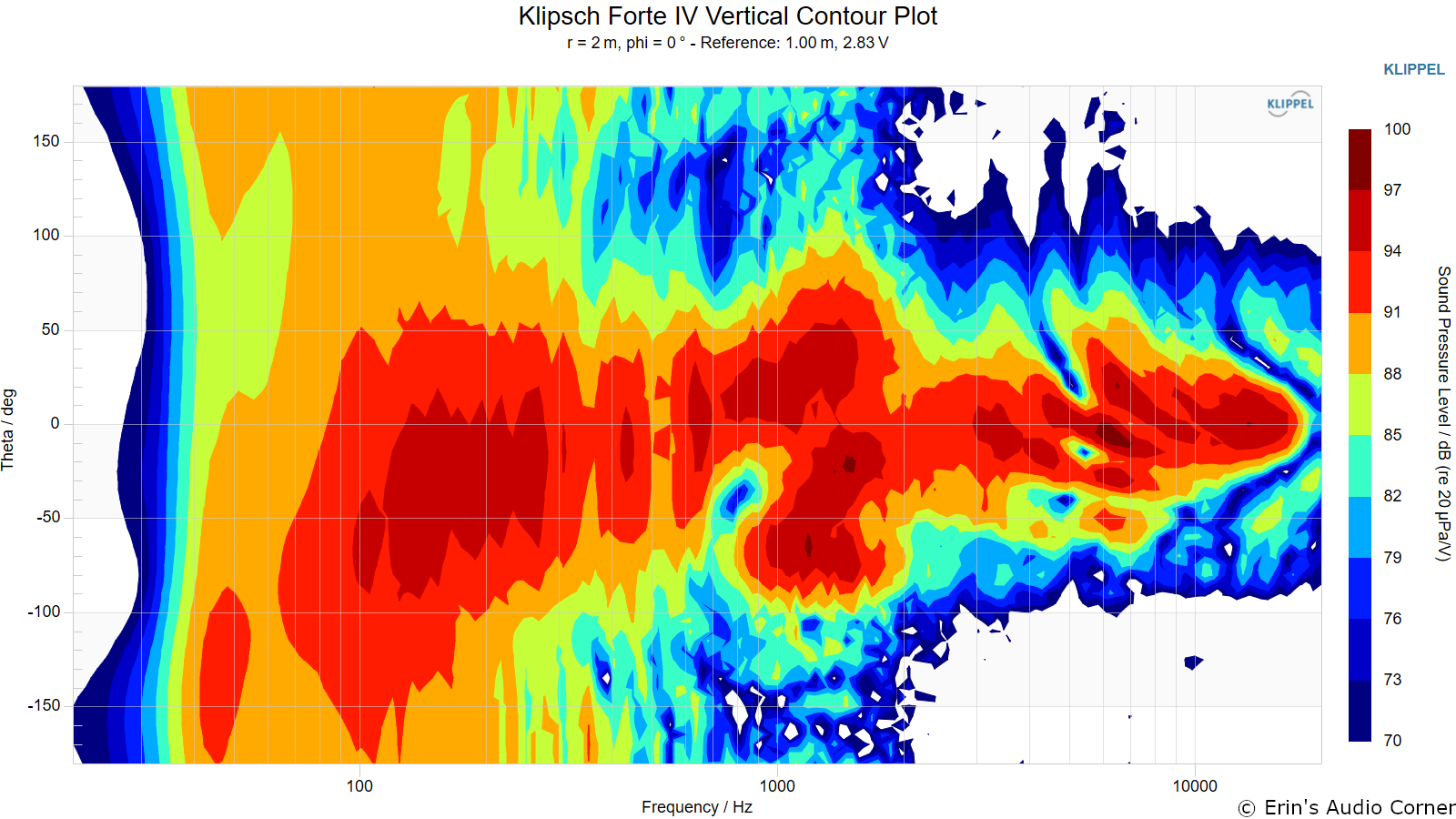
Vertical Contour Plot (normalized):

“Globe” Plots
Horizontal Polar (Globe) Plot:
This represents the sound field at 2 meters - above 200Hz - per the legend in the upper left.

Vertical Polar (Globe) Plot:
This represents the sound field at 2 meters - above 200Hz - per the legend in the upper left.

Additional Measurements
On-Axis Response Linearity

Impedance Magnitude and Phase + Equivalent Peak Dissipation Resistance (EPDR)
For those who do not know what EPDR is (ahem, myself until 2020), Keith Howard came up with this metric which he defined in a 2007 article for Stereophile as:
… simply the resistive load that would give rise to the same peak device dissipation as the speaker itself.
A note from Dr. Jack Oclee-Brown of Kef (who supplied the formula for calculating EPDR):
Just a note of caution that the EPDR derivation is based on a class-B output stage so it’s valid for typical class-AB amps but certainly not for class-A and probably has only marginal relevance for class-D amps (would love to hear from a class-D expert on this topic).

Group Delay (smoothed to 1/3-octave)
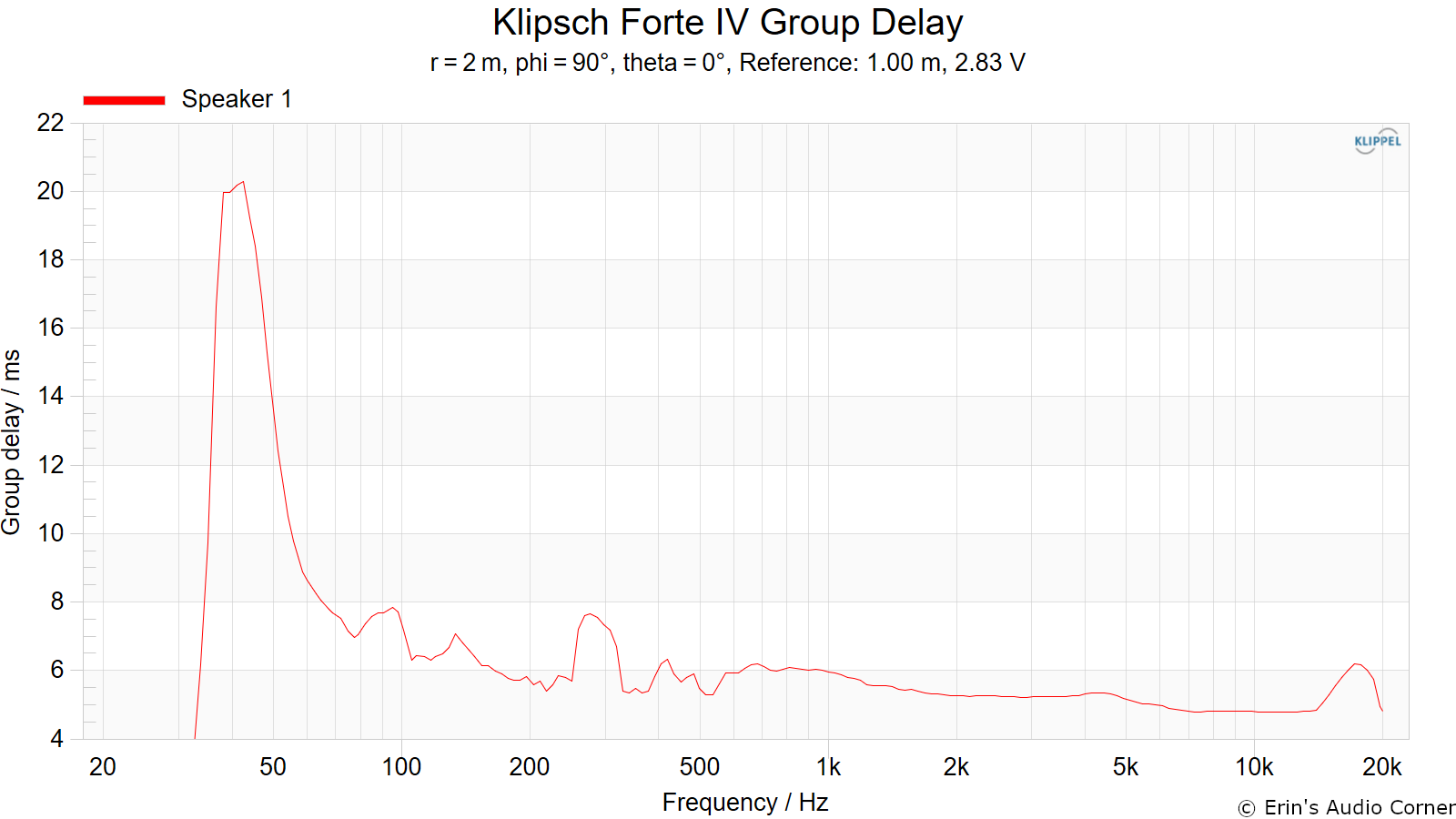
Step Response
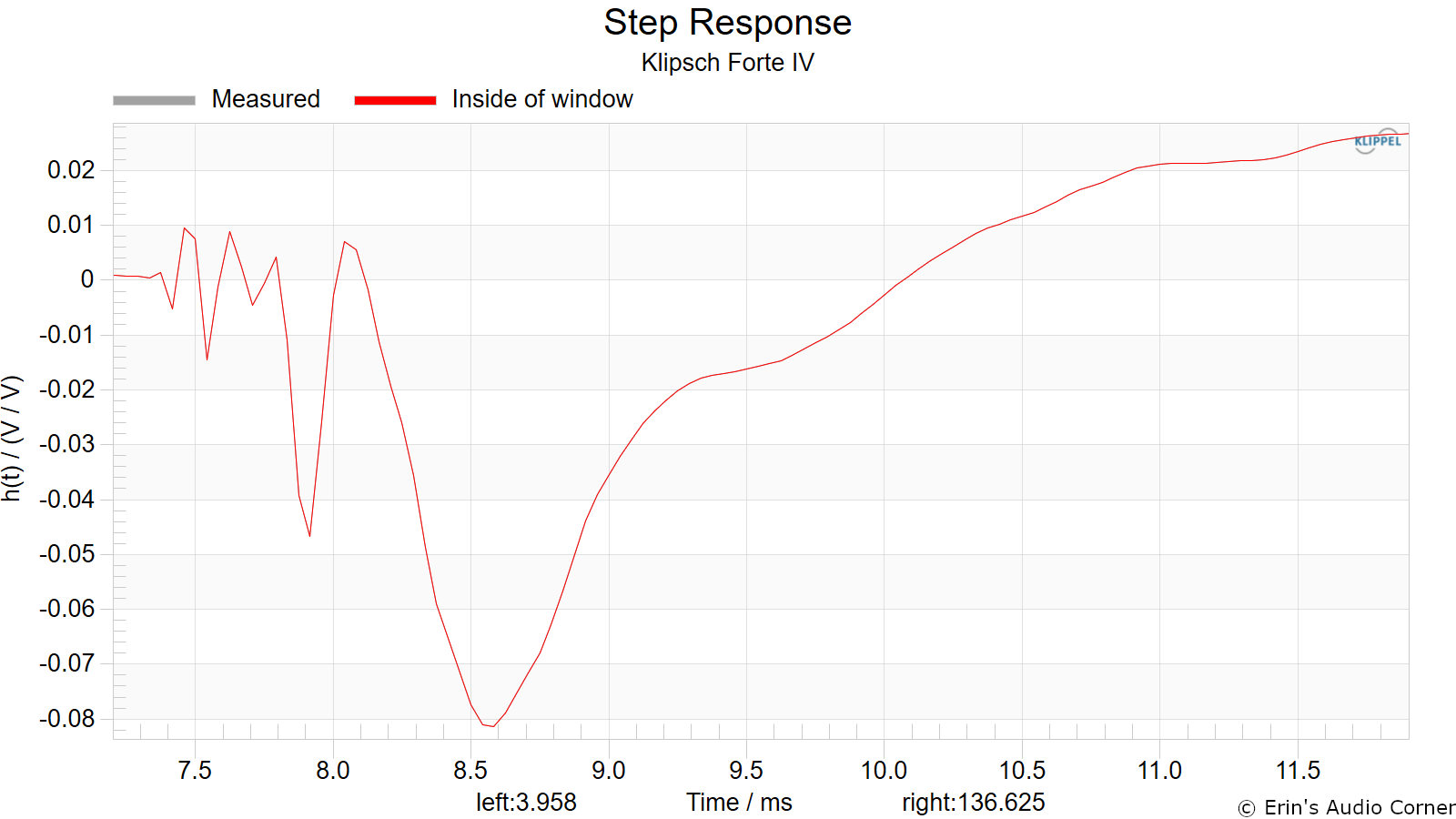
Near-Field Response
Nearfield response of individual drive units:
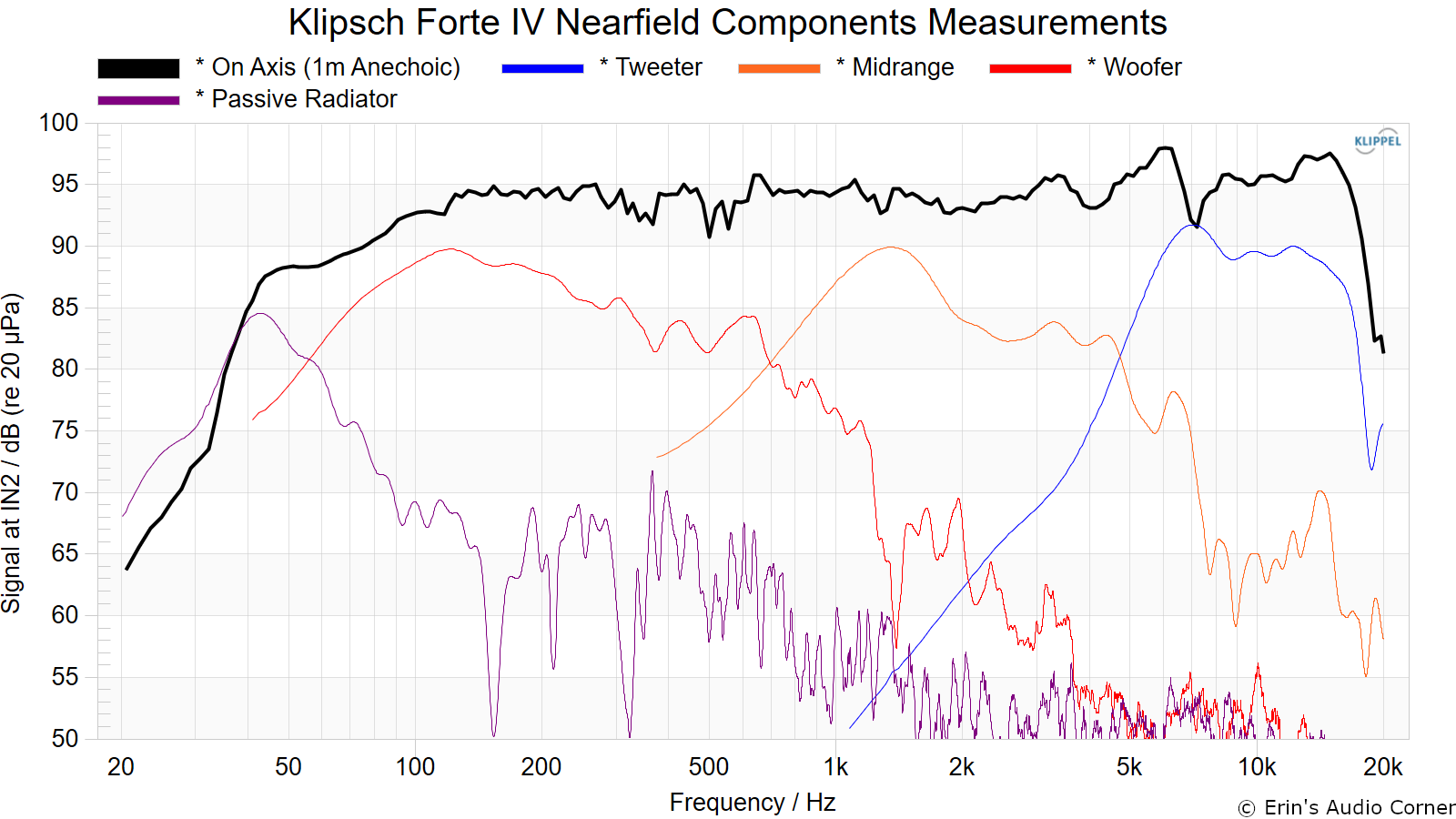
Harmonic Distortion
Harmonic Distortion at 86dB @ 1m:

Harmonic Distortion at 96dB @ 1m:

Dynamic Range (Instantaneous Compression Test)
The below graphic indicates just how much SPL is lost (compression) or gained (enhancement; usually due to distortion) when the speaker is played at higher output volumes instantly via a 2.7 second logarithmic sine sweep referenced to 76dB at 1 meter. The signals are played consecutively without any additional stimulus applied. Then normalized against the 76dB result.
The tests are conducted in this fashion:
- 76dB at 1 meter (baseline; black)
- 86dB at 1 meter (red)
- 96dB at 1 meter (blue)
- 102dB at 1 meter (purple)
The purpose of this test is to illustrate how much (if at all) the output changes as a speaker’s components temperature increases (i.e., voice coils, crossover components) instantaneously.
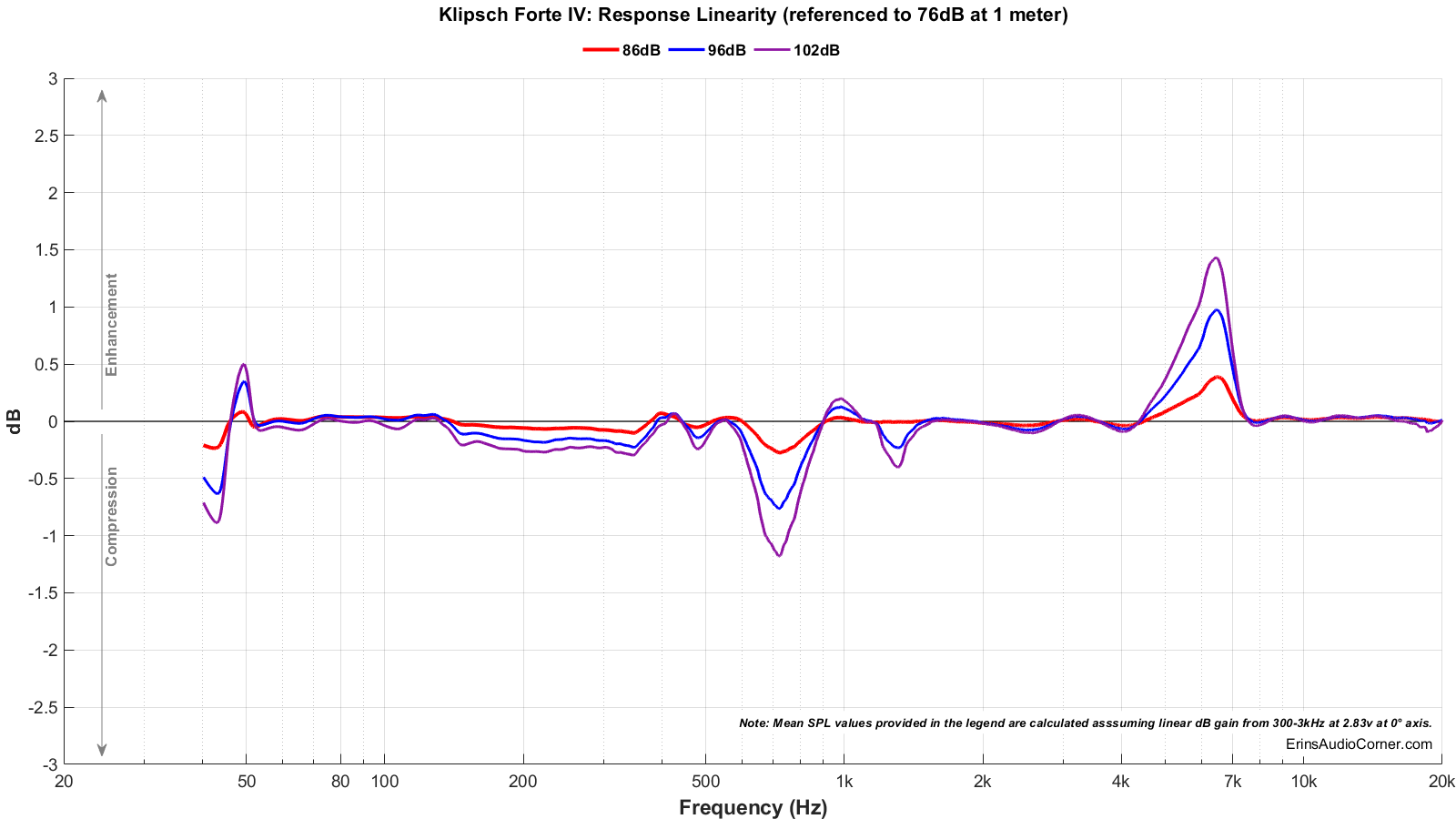
Long Term Compression Tests
The below graphics indicate how much SPL is lost or gained in the long-term as a speaker plays at the same output level for 2 minutes, in intervals. Each graphic represents a different SPL: 86dB and 96dB both at 1 meter.
The purpose of this test is to illustrate how much (if at all) the output changes as a speaker’s components temperature increases (i.e., voice coils, crossover components).
The tests are conducted in this fashion:
- “Cold” logarithmic sine sweep (no stimulus applied beforehand)
- Multitone stimulus played at desired SPL/distance for 2 minutes; intended to represent music signal
- Interim logarithmic sine sweep (no stimulus applied beforehand) (Red in graphic)
- Multitone stimulus played at desired SPL/distance for 2 minutes; intended to represent music signal
- Final logarithmic sine sweep (no stimulus applied beforehand) (Blue in graphic)
The red and blue lines represent changes in the output compared to the initial “cold” test.
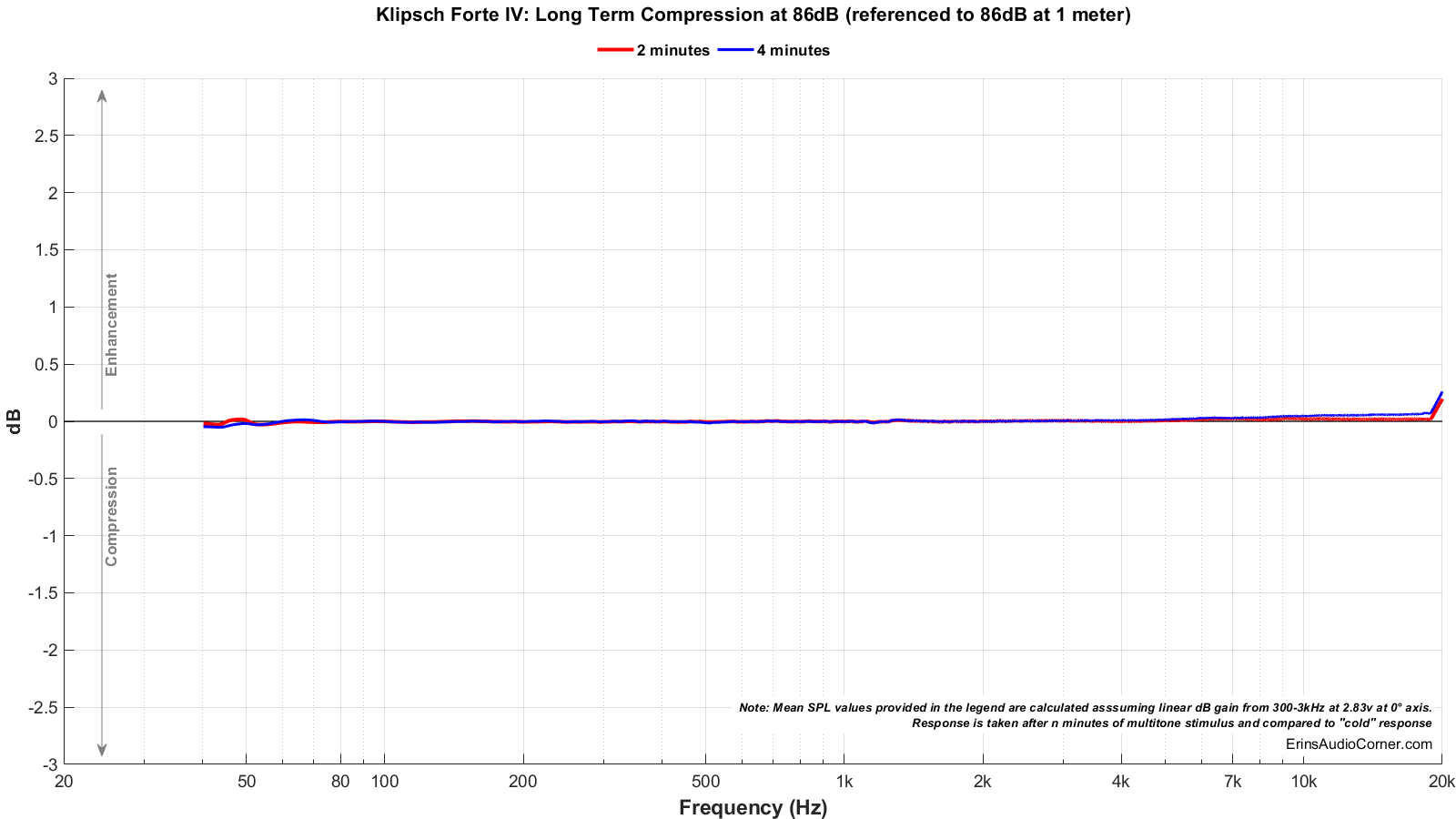
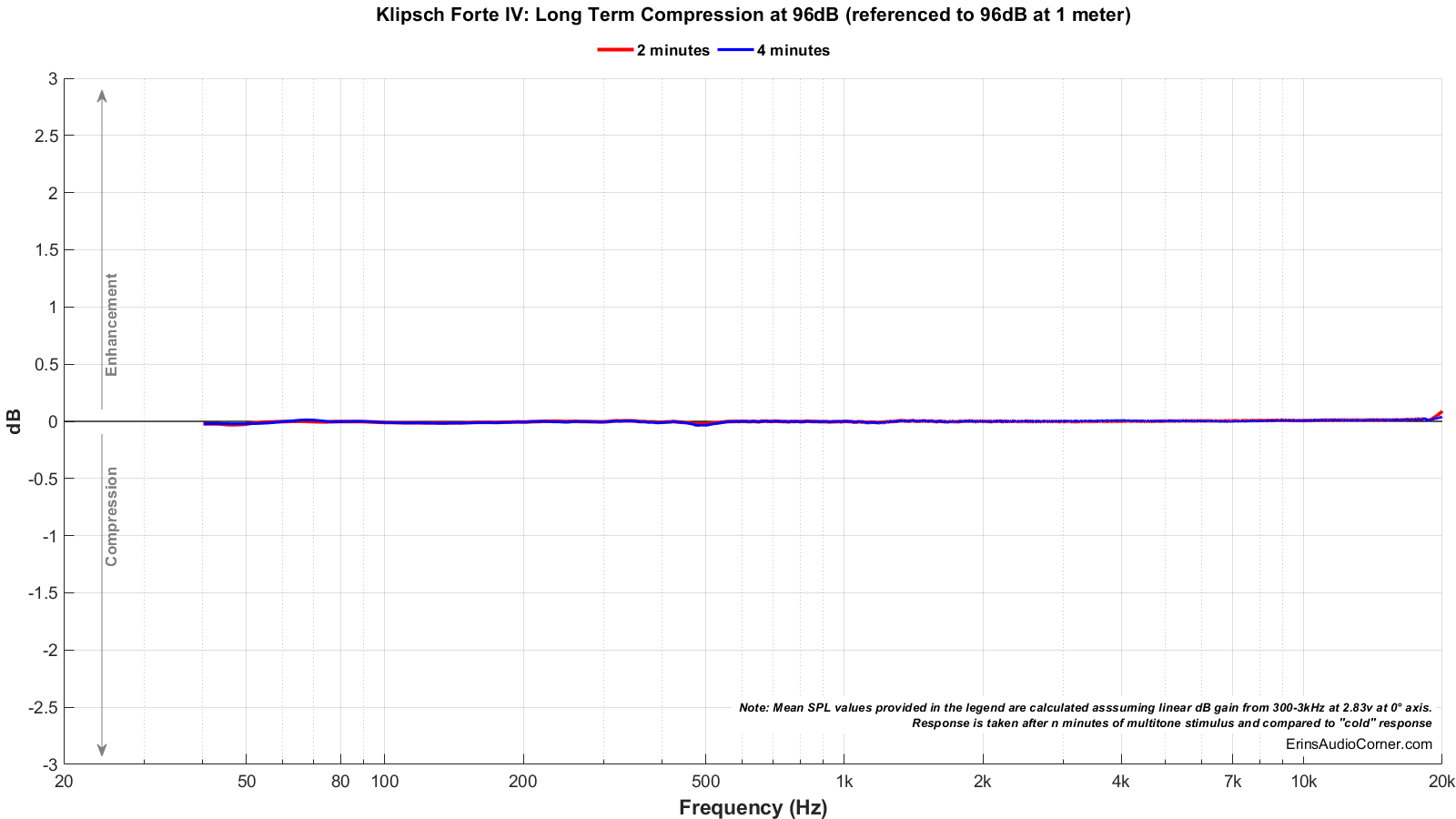
Cumulative Spectral Decay (CSD)
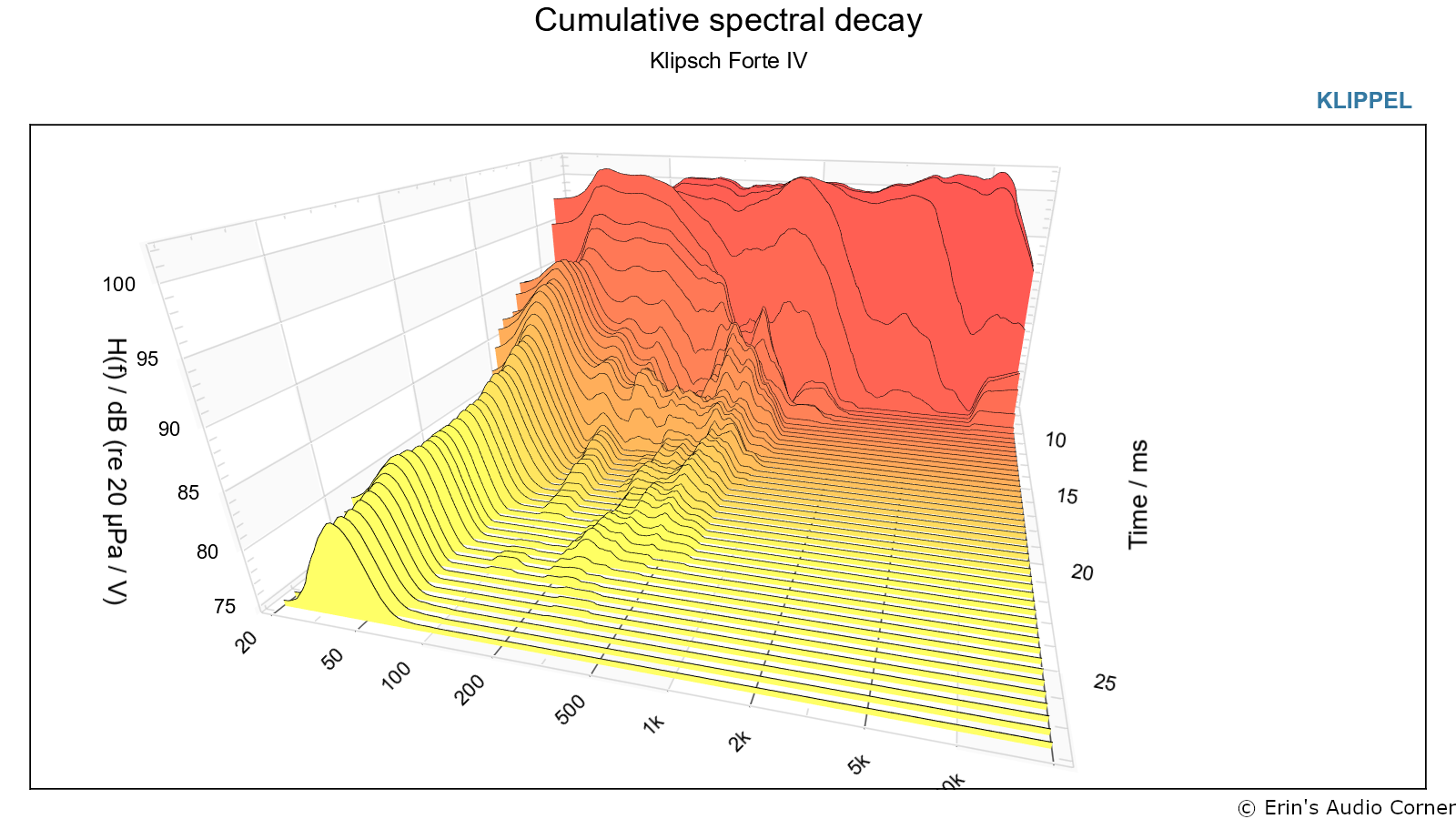
In-Room Response vs Prediction
Below is a set of measurements comparing the in-room measured response (using the moving microphone method) vs the predicted in-room response.
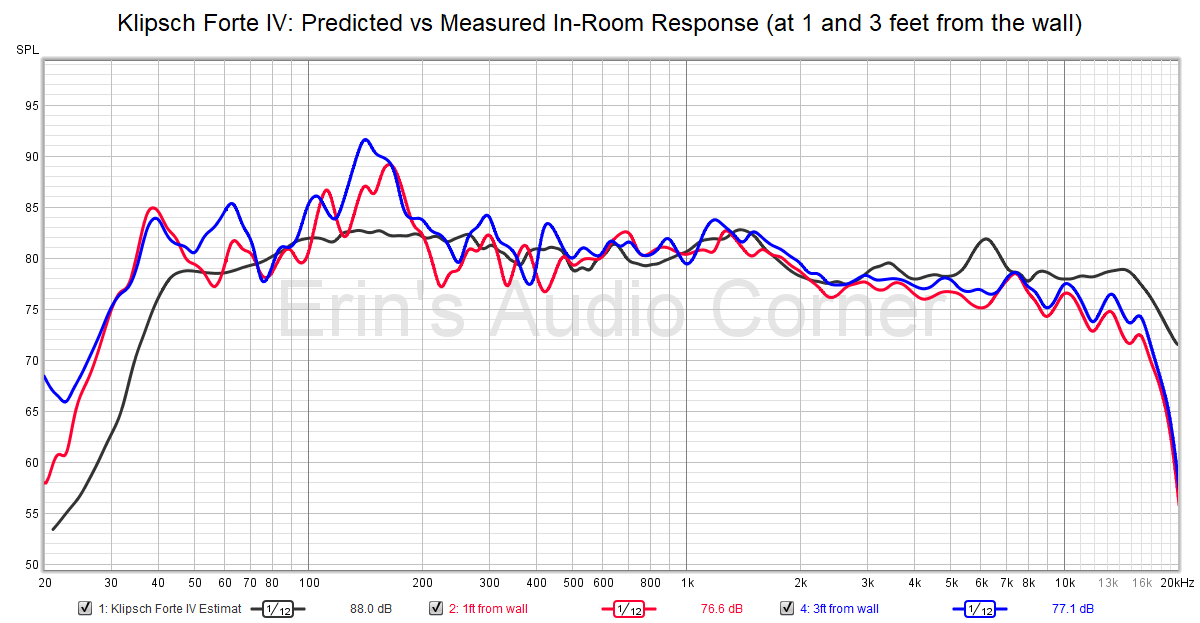
Parting / Random Thoughts
If you want to see the music I use for evaluating speakers subjectively, see my Spotify playlist.
I always listen to speakers before I measure them. This ensures I am not swayed by the measurements before I listen.
Given the number of people who assume these (as well as other Klipsch speakers) need to be listened to using a tube amplifier, I reached out to Klipsch to ask specifically what their recommendation was. Below is their quoted reply:
As far as amps go - there are many great amps out there, tubes and solid state, our speakers work well with either, they are extremely efficient and do not require much power and sound good with most amps including integrated AVR’s. That being said, a high end amplifier could make a big difference in overall experience. Tube style amps are well regarded in audiophile community but there are many great sounding options that are solid state as well. Talk to your favorite hi-fi dealer for more specific recommendations.
Under their advisement, I listened to these speakers using a Parasound HINT-6 (note: affiliate link) which was recommended to me by a Klipsch dealer.
I did some research after I listened to and measured these speakers. I found this quote on Klipsch’s product page noteworthy:
And of course, steep slope networks. Continuing the work of Paul W Klipsch, minimizing the interference band between drivers, the network of the Forte IV follows the form like the Heresy IV and Cornwall IV. One thing to note is this is a network, not a crossover. Mr. Klipsch made sure the difference was understood. A network not only provides crossover frequencies but also provides gain adjustments for the drivers, equalization of the drivers, and then adjusts the components of the network in order to provide maximum gain at the acoustic crossover. And that beyond acoustic crossover, there is a minimum to zero amplitude to affect the frequency response.”
While the high-pass filters are indeed “steep” slopes (relatively speaking), the low-pass filters are not. Both the midwoofer and the midrange show evidence of shallow low-pass slopes, something that makes itself evident in the nearfield data and contrasts the quoted portion regarding “…there is a minimum to zero amplitude to affect the frequency response”:
- the directivity dip in the 800Hz to 2kHz region
- compression data visible by the 1dB compression at 102dB at about 700Hz. Now, to be fair, this isn’t the end of the world… BUT given many will likely lean into these speakers output-wise, it’s worth noting that this is indeed a limitation in output capability as the response is altered as the volume changes.
I found that the best placement for these speakers in my room was with them moved out from the rear wall by about 3 feet. Placing them closer to the wall actually resulted in less bass, to my surprise.
The soundstage width on these speakers was really quite pleasant. It really seemed noticeably wider than with the Heresy IV speakers I had reviewed recently, though, the data doesn’t show a striking difference. However, when comparing the beamwidth, you can see that in the 500-1kHz region there are points where the Forte IV’s horizontal radiation pattern is about ±20° wider than that of the Heresy IV.
The overall tonality of this speaker wasn’t terrible to my ears but could use some work. If anything, and it sounds atypical of the standard “Klipsch sound”, I would say these speakers are a bit too subdued in the upper midrange/lower treble (2kHz to 4kHz area). However, as evidenced by the directivity index data, this area can actually be boosted a bit via EQ and made to sound better (to my ears, at least).
As stated in the Foreword, this written review is purposely a cliff’s notes version. For more details about the performance (objectively and subjectively) please watch the YouTube video.
Support the Cause
If you like what you see here and want to help support the cause there are a few ways you can do so:
-
Using my affiliate links which helps me gain a small commission at no additional cost to you.
Your support helps me pay for new items to test, hardware, miscellaneous items and costs of the site’s server space and bandwidth and is very much appreciated.
You can also join my Facebook and YouTube pages if you’d like to follow along with updates.